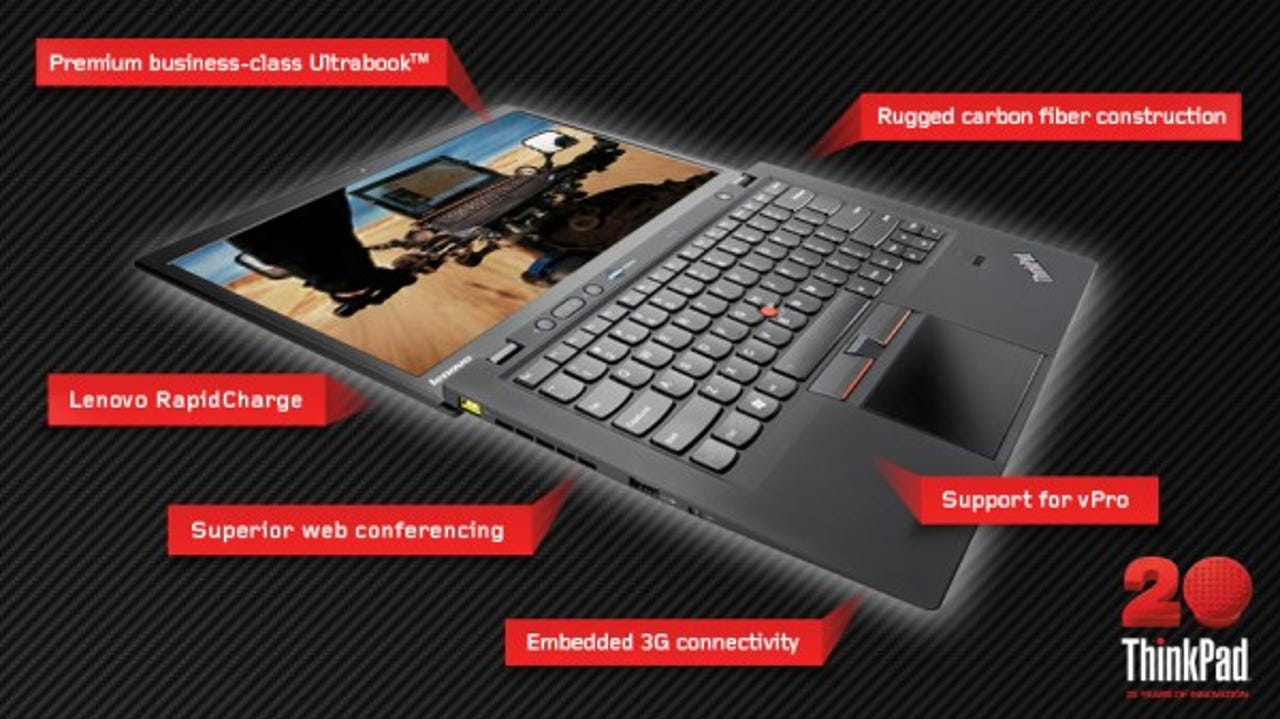Happy 20th birthday to the IBM ThinkPad: a design classic

Lenovo has just celebrated its IBM ThinkPad's 20th birthday, though it appears somewhat muted for what has been the leading brand of laptop for most of its lifetime. The Chinese company, which took over IBM's PC division in 2005, reminded us of its longevity last week when it showed off some new portables, the ThinkPad Carbon X1 and the ThinkPad Tablet 2 for Windows 8. Both are due in October.
While the ThinkPad Carbon X1 is a thin and light (1.3kg) carbon fibre Ultrabook, it would be instantly recognisable to anyone who saw the 700C at Comdex in Las Vegas in November 1992. It has an iconic black finish with the ThinkPad logo across the bottom right of the case plus, like a diminutive cherry on the cake, the essential red pointing device in the middle of the keyboard.

Of course, the ThinkPad wasn't intended to be a laptop but a tablet with touch-sensitive screen, and that's what IBM showed at the Comdex computer show in 1991. In the late 1980s, many people thought tablets represented the future of mobile computing, and as the world's largest and most powerful computer company, IBM intended to launch a successful system.
In this case, the name and branding came from IBM's motto, Think, and the standard-issue Think notepad that 30-year IBM veteran Denny Wainwright carried around in his white shirt pocket. For the full story, see ThinkPad: A Different Shade of Blue by Deborah Dell (a member of the ThinkPad team) and Gerry Purdy.
The problem was that nobody told Compaq, which was IBM's big rival in PCs at the time. In October 1989, Compaq redefined the whole portable computer industry by introducing what was effectively the first A4-sized notebook PC: the Lte Notebook PC. As an IBMer said, "Man, did the world change on us almost overnight."
IBM announced its pen-based ThinkPad tablet, the T700, in 1992, and followed up with the T710 in 1993 and T730 in 1994, but the product flopped. Meanwhile, Compaq was eating IBM's lunch.
With customers demanding an IBM equivalent to Compaq's notebook, IBM set out to produce one in a hurry. While the PC division was run from Boca Raton in Florida, IBM got the engineering done by IBM Japan in Yamoto, and the IBM research lab at Almaden, near San Jose, created the TrackPoint. The team's efforts resulted in the first ThinkPad notebook, the 700C PC, which was the hit of the 1992 Comdex computer show.
There were plenty of struggles along the way, as noted in the ThinkPad book mentioned above. By IBM corporate standards, for example, the ThinkPad should have been a pearly cream, and the TrackPoint wasn't supposed to be red, the colour IBM reserved for "emergency power off" use.
Looking back, it's hard to appreciate what a powerful and distinctive shock the ThinkPad's red-and-black styling delivered. This was not your granddad's IBM.
The ThinkPad 700C was a smash hit, and in two years it took IBM's portable PC business from $120 million a year (on which it lost $240 million) to $3 billion.
As you might guess, I used ThinkPads for many years, and a particular favourite was the ThinkPad 240X (PDF), launched in May 2000. This was small and light (also 1.3kg), and it didn't have either a floppy drive or a CD/DVD optical drive built in. It was the MacBook Air of its day, except the ThinkPad had a much better keyboard than the Mac, and felt better made. (Mine was made in Greenock in Scotland, before IBM moved production to China to cut costs.)
Although the 240X had a limited specification -- 500MHz Mobile Pentium III with 64MB to 192MB of memory and Windows 2000 -- it was comfortable enough for my peripatetic journalistic purposes: word processing, email and web browsing. The main reason for eventually replacing it was the limited 800 x 600 resolution of the 10.4inch screen, which prompted my move to an X31.
As you might also guess, travelling ThinkPad users form a sort of secret society -- people of taste and discernment -- though it's a commendably egalitarian one. If you have a ThinkPad, nobody cares which one it is. I found it strikingly different to using Mac portables, where people look down their noses at you if you don't have the latest model. (I'm often three or more years behind.)
It's also a society that has included Steve Jobs's illegitimate daughter and various ex-Apple staff, including former boss John Sculley.
Lenovo's birthday party was held in a private room in New York's Museum of Modern Art, and China Daily's report included a picture of the cake. While I'm not sure how Lenovo picked the date, the ThinkPad line of notebook PCs (not touch-screen pads) was announced on 5 October 1992 at 590 Madison Avenue, IBM's former headquarters in New York. There's still the chance to have a bigger and better party, though I'd quite understand waiting for the 25th anniversary instead.
The ThinkPad line is a design classic. It will still be around...